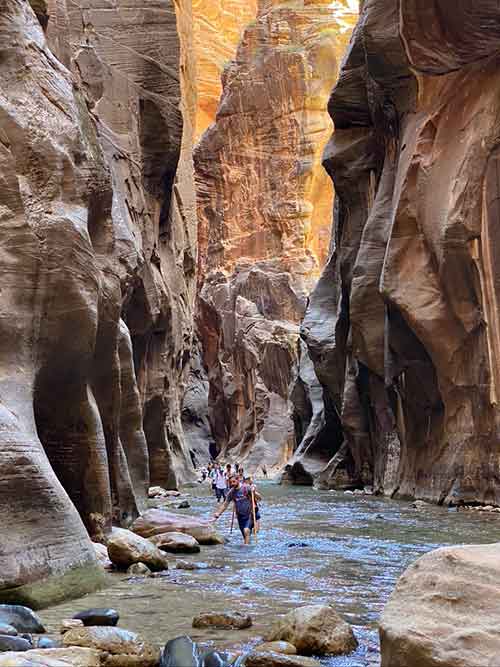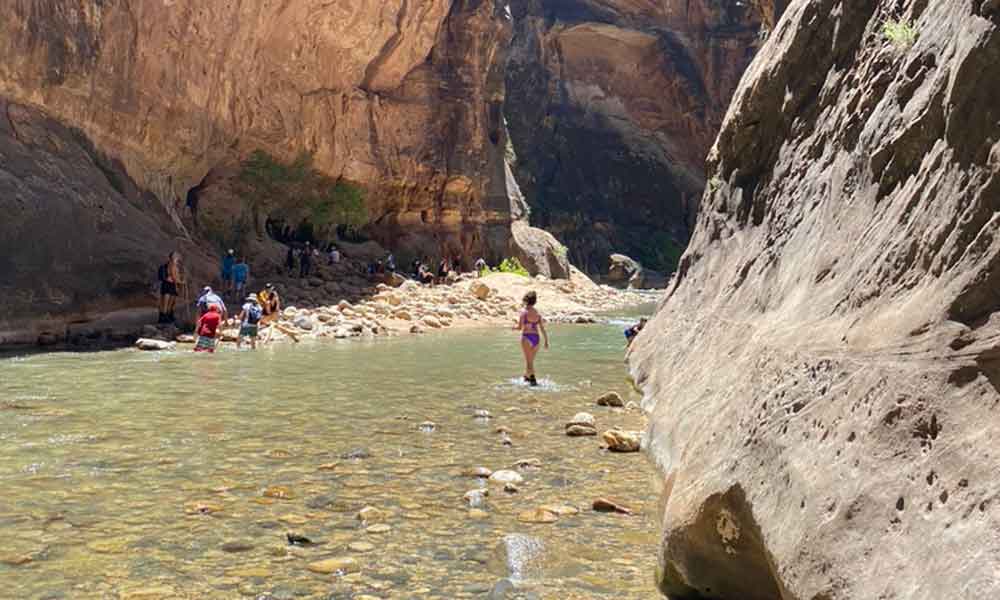Utah’s Narrows, located in the Zion National Park, is iconic. Its most famous hike goes through the narrowest section, as little as 20-30 feet wide. The “trails” require trekkers to be in the water for almost the entirety of the journey. The hike’s difficulty depends on the route, water level, and weather. But even the mildest conditions require checks and gear that are relatively unique.
Hiking the Narrows requires planning ahead for permits and special gear. Hikers must choose between low water levels and sweltering conditions or higher water and cooler conditions. Unfortunately, flash flood warnings can come anytime. Hikers will need trekking poles and toe covering footwear.
The Zion Canyon creates a unique visual experience colored by the gorgeous Navajo sandstone. For those who can’t make the journey, there is a wheelchair-accessible, paved Riverside Walk extending from the Temple of Sinawava. This section does not require a permit and can provide everyone with a taste of the Narrows. But for those wading in, there is much more to consider.
Permits Required To Hike The Narrows
The Narrows requires permits to do some of their hikes. However, the most accessible hikes do not require permits.
No Permit To Do Riverside Walk Or Bottom-Up To Big Spring
A permit is not required for the Riverside Walk. Nor is one needed for the day-adventures that begin “Bottom-Up,” starting at the Temple of Sinawava. You can hike upstream to Big Spring, which is approximately five miles, before being required to head back. Many day visitors turn well before Big Spring.
When you hear of families with children doing the Narrows, they typically choose a portion of this route. There are also periods when the water is shallow enough for shorter people to manage. It is a ten-miles round trip, but you can turn around whenever you like.
Permit Required: Chamberlain’s Ranch To Temple of Sinawava
Those hiking the 16-mile “Top-Down” option from Chamberlain’s Ranch to Temple of Sinawava will need a permit. They will also be required to have a separate backcountry permit if camping during the journey.
- Day trip permit information can be found here.
- Camping permit information can be found here.
- More information on campsite options can be found here.
Transportation For Hiking The Narrows
The Narrows has two shuttle systems:
- Zion Canyon Shuttle
- Springdale Shuttle
The shuttles are free and essential, as parking inside Zion is limited and certain routes restricted during high season. These shuttles are used by people doing Bottom-Up and for the end of the Top-Down. The schedules change depending on the season and are not necessarily the same each year. Thus, do make sure you have the latest schedules before embarking.
It is essential to wear a waterproof timepiece when hiking to ensure you get back before the last shuttle departs. For those doing Bottom-Up, it is as simple as turning around in a timely manner.
Unfortunately, there is no transportation to Chamberlain’s Ranch for those doing Top-Down. However, you will be using the shuttles for the end of your journey. Therefore, you need to set off early to ensure you are not stranded at the end of your hike. To plan your set-off time, you need to be aware of the conditions and how fast you can realistically hike in water. There are places where you may be up to your waist, trying to slosh through.
Pros & Cons Of Hiking The Narrows In Each Season

Summer and early fall are the Narrows’ peak seasons. However, the Narrows is open year-round so long as conditions allow. No season guarantees safety. Flash floods can occur at any time, so you must know current conditions before heading out. Always wise to discuss your plans with a ranger before wading in.
Heatstroke can happen in hot weather. However, people can also forget that the Narrows can be dramatically cooler than the areas outside of the canyon and neglect to bring warmer clothes.
Pros & Cons Of Hiking The Narrows In Summer
Summer is high tourist season in the Narrows. The water level is lower, making it more accessible to people under 5-feet tall. When people tell you that hiking the Narrows is easy and not strenuous, they’ve typically done only a few miles from Bottom-Up in summer when the water was very low.
People are also more inclined to do a water hike when the weather is hot, and in this area, summer can be sweltering. The water can still be pretty cold in June, but it will become noticeably warmer by mid-July.
On the negative side, this is the season it will be the most crowded. In addition, hikes are frequently canceled due to flash flood warnings since summer is also thunderstorm season.
Warmer weather also increases the likelihood of high levels of cyanobacteria toxins. The Virgin River, which flows through the Narrows, is notorious for this deadly algae bloom, and no season is considered “safe.” But it is typically worse in warmer weather, especially if the water has warmed.
Pros & Cons Of Hiking The Narrows In Fall
Fall is considered the optimal time to hike the Narrows. The water is often still warm, but the weather is no longer sweltering. The risk of thunderstorms and flash floods is reduced. There are fewer crowds due to school being back in session, and the sunlight is at the best angle to set off the spectacular colors of the canyon. The autumn foliage only adds to the dramatic visual experience.
On the downside, the cyanobacteria toxin can still be a nuisance. Also, the weather can bounce between hot and cold, making it hard to pack light. Lastly, daylight is lessening, which provides less of a hiking window. Hiking the Narrows in the dark is not advised. The reduced shuttle schedule creates further time pressure.
Pros & Cons Of Hiking The Narrows In Fall
Winter is a beloved season to do the Narrows by experienced hikers with proper gear such as a dry suit and neoprene socks. Hikers must be fit, as daylight is scarce, so speed is essential. But the crowds are gone, the scenery very pretty, and the air crisp. The risk of the deadly algae bloom is at its lowest, and flash floods are less likely, although they are never impossible.
Transportation and getting there can be difficult. Snow can cut off access to areas, even with a 4Wd, including Chamberlain ranch. Ice can fall off the canyon walls, creating a new hazard to hikers. Thus, almost all of the Narrow hikes will be from the Bottom-Up.
Pros & Cons Of Hiking The Narrows In Spring
Spring is the worst season to attempt the Narrows. Most years, it will be shut from mid-March through May. The snowmelt from surrounding areas causes the water level to rise to dangerous levels and speed. Also, the excess runoff causes the water to be murky, causing further hazards.
Thus, while spring is a beautiful time of year to visit Zion National Park, with an abundance of fantastic hikes and sights, the likelihood is low that the Narrows will be open. In the event access is open, the water will be high, making it a very strenuous hike.
Equipment Required For Hiking The Narrows
Hiking in the Narrows has different challenges due to the trail being in the river rather than alongside it. So while much of the equipment recommended is similar to a typical hike, its rank of importance often differs.
Basic equipment requirements for a summer-fall hike:
- Proper layers, including fleece or wool
- Closed-toe shoes with good sole
- Neoprene socks
- Trekking poles, preferable two, but at least one
- Quick-drying UPF pants
- Dry bag
- Waterproof case or pouch for phone
- Drinking water, including hands-free water pouch
- Tub for human waste
- Dry clothes waiting in your car or pick up point
- Sunscreen
- Hat
- First aid kit
Why You Need Shoes For the Narrows
Many people think they don’t need shoes to do the Narrows because it is in the water. However, closed-toe shoes with a decent sole are essential to prevent injury and provide enough grip. The surface is uneven, and the water pushing at your legs reduces your balance. Bare feet lead to injury to toes, soles, knees, and ankles. It also heights the chances that you fall.
Neoprene socks can help keep your feet warm when the water is cooler. However, they are not a substitute for shoes.
Why You Need Trekking Poles For the Narrows
The Narrows is slippery, rocks can move underfoot, and depths can unexpectedly plunge. Trekking poles provide balance and allow you to test the terrain ahead. It is advised you have two, but some people do hike with only one pole or staff.
Why You Need A Water Pouch For the Narrows
Hands-free water is essential. You don’t want to drop your water bottle into the river and lose it. Also, your hands will be busy holding your poles. Bring as much of your own water as you can carry. Filter systems and boiling water will not necessarily make the water safe from the deadly toxin.
Why You Need A Waste Tub For the Narrows
It is illegal to leave solid human waste in the Narrows. You must hike it out in a safe container or human-waste bag. While you are encouraged to use the bathroom before leaving, it is understood that needing to pee will happen in longer hikes. But unfortunately, a “number two” must be done into a container, not the water, on a bank, or a rock. This container must be packed out.
This is for the health of your fellow hikers, the water (which is already suffering from algae blooms), and to help preserve the canyon.
Conclusion
The Narrows is an unforgettable experience as hiking goes in Utah. No matter which route or time of year you go, be safe, pack appropriately, and respect the park rules. Enjoy this amazing natural wonder. Read more about the best hikes in Zion National Park.







